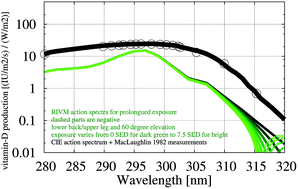The action spectrum for vitamin D3: initial skin reaction and prolonged exposure
Abstract
Vitamin D3 photosynthesis in the skin is formulated as a set of reaction equations, including side-reactions to lumisterol, tachysterol and toxisterols, and the accompanying reverse reactions, isomerisation of previtamin D3 to vitamin D3 and photodegradation of vitamin D3. The solution of this set is given for the stationary irradiance spectrum. The effective action spectrum for the instantaneous vitamin D3 production changes shape as a function of exposure, and therefore, no single action spectrum can be used. We assessed the action spectrum for unexposed skin and for skin that has been exposed to 7.5 Standard Erythemal Doses (SED). We constructed two new estimates: (1) the RIVM action spectrum, based on absorption spectra, quantum yields and skin transmission spectra, and (2) the modified QUT action spectrum, which is adjusted for self-absorption and skin transmission. For previously unexposed skin, the modified QUT action spectrum gives a qualitatively similar, but larger estimate than the RIVM action spectrum. We have not been able to solve the lack of quantitative agreement between the vitamin D production estimates from the three action spectrum estimates (RIVM, modified QUT and CIE). All new action spectra have stronger emphasis on the short wavelengths than the CIE action spectrum. We showed that, for wavelengths larger than 300 nm, the bandwidth that was used in the experiment that formed the basis of the CIE action spectrum, gives a red-shift of about 1 nm. Generally, with the formation of previtamin D3, the return reaction to provitamin D3 limits the production of vitamin D3. After some exposure, the new action spectrum has negative values for the longer wavelengths in the UVB. For the RIVM action spectrum, this happens after 7.5 SED, for the modified QUT action spectrum already after 1.25 SED, and after 7.5 SED the net production rate is largely cancelled. Thus prolonged exposure of previously unexposed skin saturates vitamin D3 formation. For maximum vitamin D production after 1.25 SED, sunscreens should block wavelengths larger than 310 nm. Sunscreens that block only UVB could result in reduction in vitamin D production after prolonged exposure, or even a destruction of vitamin D that has just been formed.


 Please wait while we load your content...
Please wait while we load your content...